South - Near the Coast
Take Highway 101 north to Highway 37 at Novato, east on Highway 37 to Highway 121, north on Highway 121 to Highway 29 near Napa, north on Highway 29 to the park entrance.
South - Inland
Take I5 north to I580, west on I580 to I680, north to I780, north to I80, east to Highway 37, west to Highway 29, north on Highway 29 to the park entrance.
North - Near the Coast
Take Highway 101 south to Calistoga exit, go east on Mark West Rd., continuing on Porter Creek Rd. to Petrified Forest Rd., turn left, go to Highway 128, turn right and follow Highway 128 past Calistoga to the park entrance.
North-Inland
Take I5 south to Highway 20, west to Highway 53, south to Highway 29 at Lower Lake, then south on Highway 29 to the park entrance.
East
Take I80 west to Highway 12, west to Highway 29, then north to the park entrance.
Activities
Hiking: there are well over 10 miles of trail.
Swimming: Memorial Day weekend through mid-June, then daily through Labor Day, from 12- 6 p.m. There is an additional fee for the use of the swimming pool, to be paid at the park entrance.
Horseback riding: horseback ride during the spring, summer, or fall. Reservations for horseback rides can be made through Triple Creek Horse Outfit by calling (707) 933-1600.
Picnics: The large picnic grounds are located in the day use area, and are even available for group events and getaways. A covered area for group use contains picnic tables, a sink and an electrical outlet with a horseshoe pit and wheelchair-accessible restroom nearby.
Interpretive programs: offered throughout the year. Special programs can sometimes be arranged for groups by calling the park in advance.
Seasons/Climate Recommended Clothing
The park exhibits more seasonal changes than most Californians experience. Hot, dry summers change to mild, wet winters; in between, in spring and fall, the park and its surrounding area are probably at their finest.
Summer temperatures may reach 105 degrees Fahrenheit, but nights are usually cool. In the fall, when daytime temperatures are more pleasant, the leaves begin to turn, creating a dramatic and colorful display.
Temperatures don't often go below freezing and snow is infrequent, but nearly 45 inches of rain are apt to fall during a single winter - between December and March.
More about the park
Most of the park is rugged, with elevations ranging from 300 to 2,000 feet. You will notice a pattern in the vegetation: the forests are on the north-facing slopes and in canyons, while south-facing slopes tend to be brushy; redwoods grow only near creeks or springs.
Plant life hides much of the park's geology, which is principally volcanic, but you can see a reminder of the area's violent geologic past in the volcanic ash cliffs of upper Ritchey Canyon.
The park is home to raccoons, gray squirrels, deer, foxes, bobcats, and coyotes to name a few, but they are sometimes difficult to spot because of their nocturnal habits and the heavy forest cover.
Several species of birds can be easily detected though, including the six kinds of woodpecker that inhabit the park. The spectacular crow-sized pileated woodpecker is one of them. On a more rare occasion a spotted owl can be found, perched high in a redwood tree.
Located by the entrance to the park is the Visitor Center. The Visitor Center and entrance station are open intermittently when staffing is available. Brochures (hiking maps) are also available by mail.
Next to the park's visitor center is the Native American Garden which displays some of the plants important to the first people of this area. Today, many of the same plants are used by the Wappo people. A guide for the garden is available by mail or in the visitor center to broaden one's understanding of the first people.
Near the day use/picnic area is the Pioneer Cemetery, resting-place of some of the original settlers of the Napa Valley. The cemetery is an interesting place to visit while on a day hike, and is currently under restoration to return it to its original, mid-1800's appearance.
Wine Science
"Bright, accessible fruit." "Complex minerality." "Rounded corners."
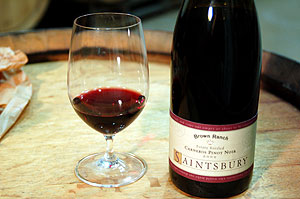 Wait a minute... wine has corners? Well, in a manner of speaking. What wine definitely has is complex chemistry that changes over time, and lends each vintage its own distinctive taste-- one that reflects the environment the grapes are grown in and the scientific decisions of the winemaker. The resulting tastes and aromas are so intricate that wine lovers have their own rich vocabulary to describe them. (We'll get to those "corners" in a minute.)
Wait a minute... wine has corners? Well, in a manner of speaking. What wine definitely has is complex chemistry that changes over time, and lends each vintage its own distinctive taste-- one that reflects the environment the grapes are grown in and the scientific decisions of the winemaker. The resulting tastes and aromas are so intricate that wine lovers have their own rich vocabulary to describe them. (We'll get to those "corners" in a minute.)
The Acid Test
The acids in wine are important in lending a crisp, fresh taste that balances the natural sweetness of the grapes and helps give the wine liveliness. Too much acid, though, makes a wine taste sharp, and too little leaves it lifeless. There's a bit of personal preference involved here, too: just as some people favor grapefruit over apple juice, some wine drinkers prefer a more acidic wine.
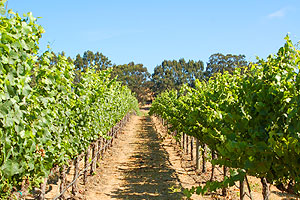 Acidity can also reflect the climate in which the grapes were grown. As they grow, grapes produce two acids, tartaric and malic, and compounds derived from these acids are found in finished wine. Grapes grown in cooler temperatures will typically be more acidic than those grown in warmer climes because in warmer temperatures, the grapes can "sweat out" some of their acids through respiration. What does this mean for you as a wine drinker? You can expect a Chardonnay from the somewhat toasty Napa Valley to be less acidic than one from the cooler Burgundy region of France. This is one clue an experienced wine taster can use in determining the region where a wine's grapes were grown.
Acidity can also reflect the climate in which the grapes were grown. As they grow, grapes produce two acids, tartaric and malic, and compounds derived from these acids are found in finished wine. Grapes grown in cooler temperatures will typically be more acidic than those grown in warmer climes because in warmer temperatures, the grapes can "sweat out" some of their acids through respiration. What does this mean for you as a wine drinker? You can expect a Chardonnay from the somewhat toasty Napa Valley to be less acidic than one from the cooler Burgundy region of France. This is one clue an experienced wine taster can use in determining the region where a wine's grapes were grown.
Tannins and Tinted Teeth
Tannins are an altogether different family of chemicals and flavors (though some wine tasters confuse the two). To sense the difference, swish a sip of wine between your teeth. The acid will make your mouth water. The tannins will leave behind a dry, astringent feeling.
Found mostly in red wines, tannins are a group of chemicals that lend body and structure to a wine (those mysterious "rounded corners"). Tannins readily bind with proteins in your saliva and can stick to your teeth when you swish-- leaving serious tasters somewhat burgundy-toothed. Wines with lots of tannin are sometimes considered "big," because they have a dense texture, though a wine that's "too big" can taste harsh. Highly tannic wines can be tempered by fatty foods, like bleu cheese, which coat your mouth and keep the tannins from reacting with your saliva.
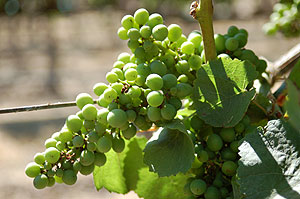 Wine acquires tannins from grape stems, skins, and seeds, and from wood if it's aged in oak barrels. Winemakers can control tannin level in a wine by altering factors like how long the juice remains in contact with the skin after the grapes are crushed and how long the wine is aged. They consider not only the flavor of the wine, but whether or not they intend for it to be consumed soon after bottling or to be aged.
Wine acquires tannins from grape stems, skins, and seeds, and from wood if it's aged in oak barrels. Winemakers can control tannin level in a wine by altering factors like how long the juice remains in contact with the skin after the grapes are crushed and how long the wine is aged. They consider not only the flavor of the wine, but whether or not they intend for it to be consumed soon after bottling or to be aged.
Uncorking a Great Debate
A wine's tannins soften as it ages, so highly tannic wines are good candidates for the cellar. Wine researchers don't have a clear understanding of exactly what happens chemically as a wine ages, but they do know that the changes are fueled by oxygen. The wine itself contains some of the gas when it's bottled, and tiny amounts of oxygen seep in around the cork.
The importance of the "leaky cork" in the aging process is central to a debate raging in the wine community. While corks have a romantic aesthetic and may contribute to the maturing of a fine wine, they are also responsible for most of the spoilage that occurs. "Cork taint" results when a cork contains one of a number of compounds that impart a musty or medicinal smell to a finished wine. Cork taint affects between 5 and 8 percent of wine bottles, a significant enough percentage to send winemakers looking for other options. One of them, the screw cap, has been both lauded as a savior and dismissed with indifference.
Winemakers from Down Under-- Australia and New Zealand-- have taken the lead in pushing this alternative to corks. Advocates note there's no worry of contamination from a screw cap and it provides an airtight seal that can prevent oxidation. But screw caps don't quite carry the allure of a cork. And from a scientific perspective, can a wine still age finely without the tiny bit of oxygen afforded entry by a cork? It's hard for wine researchers to answer this question, since there's no clear picture of exactly what's going on inside the jug. The jury may be out for years, until connoisseurs open their decade-old screw-capped bottles and confer.
"Manipulation" vs. "Cheating"
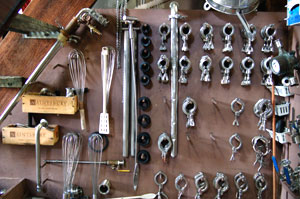 Have a look at a wine label and you'll see items like alcohol content, the producer, and the vintage year. What you won't see is a list of ingredients. While it's true that wine is pretty much just grapes and the yeasts used to ferment them, winemakers will often tweak flavors or coax a developing process along. Winemaking regulations differ throughout the world; in sweltering California, it's common practice to dilute wine with water to control the high alcohol content that results from sugary-ripe grapes, or to add acid lost through respiration. Such embellishments are forbidden in more temperate Burgundy, where winemakers often add sugar (a process banned in California) to make up for its lower content in their fruit.
Have a look at a wine label and you'll see items like alcohol content, the producer, and the vintage year. What you won't see is a list of ingredients. While it's true that wine is pretty much just grapes and the yeasts used to ferment them, winemakers will often tweak flavors or coax a developing process along. Winemaking regulations differ throughout the world; in sweltering California, it's common practice to dilute wine with water to control the high alcohol content that results from sugary-ripe grapes, or to add acid lost through respiration. Such embellishments are forbidden in more temperate Burgundy, where winemakers often add sugar (a process banned in California) to make up for its lower content in their fruit.
These types of manipulations occur before adding yeast, and are viewed by most wine enthusiasts as corrections to the deficiencies of nature. Other tweaks, however, are made after yeast is added, and might be viewed differently.
Perhaps the most visible example is the sulfites that are often added to wine. These compounds keep harmful bacteria and other microbes at bay, but some consumers say they'd prefer wines without them. In response, a number of organic wineries have adopted a "no sulfites" practice. Many wine aficionados argue that it's difficult to make a good quality wine without sulfites, and that, since sulfites already occur naturally in small amounts during fermentation, people don't actually avoid them just by drinking organic wines.
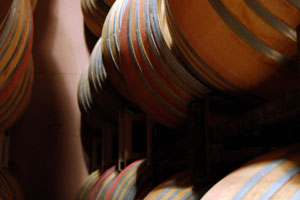 More subtle questions also arise around manipulations that can alter the taste or aging process of a wine in ways that might seem artificial. A winemaker can choose to age his latest batch in newer barrels to impart an oakier flavor. Or he could speed up the aging process by injecting small amounts of oxygen into the barrel (a process known as microoxygenation). Both actions intentionally alter the wine. While the first method is one that's been practiced for centuries, the second is relatively new. Does that make the newer one "cheating"? Some wine drinkers would say that whatever improves the quality of the wine counts the most, while others would argue that using more traditional methods preserves the integrity of the winemaking.
More subtle questions also arise around manipulations that can alter the taste or aging process of a wine in ways that might seem artificial. A winemaker can choose to age his latest batch in newer barrels to impart an oakier flavor. Or he could speed up the aging process by injecting small amounts of oxygen into the barrel (a process known as microoxygenation). Both actions intentionally alter the wine. While the first method is one that's been practiced for centuries, the second is relatively new. Does that make the newer one "cheating"? Some wine drinkers would say that whatever improves the quality of the wine counts the most, while others would argue that using more traditional methods preserves the integrity of the winemaking.
You won't read about these behind-the-scenes manipulations on a wine label, but there's still a lot to be learned from the packaging. Knowing where a wine is produced, for example, can give you clues to how it might taste (remember the "lower acidity in warmer climates" hint?). If you know what you're looking for, the label can help you discern whether all the grapes are from the same region or, if it's a blend, how much of each kind of grape is used. There are many types of grapes, called varietals, each having its own unique qualities.
Sometimes labels include a description of the wine's flavors; try tasting the wine and see if the description matches your experience. For more of a challenge, spend some time contemplating a wine's aroma. Download these lists with common terms used to characterize scents found in a wine's bouquet. With a little practice, you just might find yourself talking about "grapefruit," "pepper," and those no-longer-elusive "rounded corners."
Special thanks to David W. Graves of Saintsbury Vineyard for his kind assistance providing insights for this Exploration.
Latest Visitor Photos





